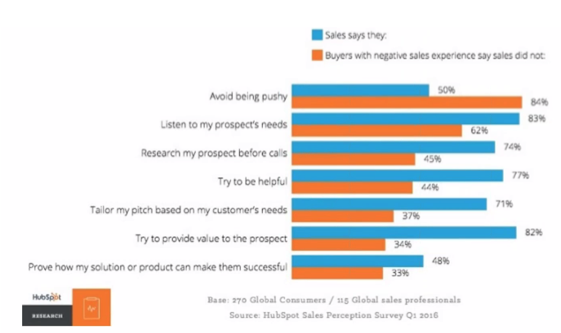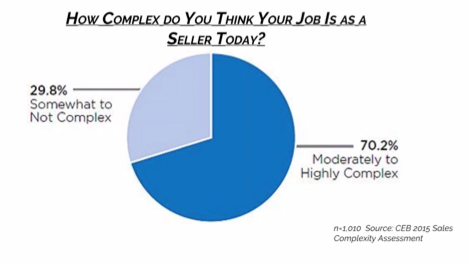
The perspective from which we look at our world dictates our expectations and our behavior. As our points of view change, so too will our attitudes and our actions. As the great philosopher (and comedian) George Carlin once said, “Some people see the glass half full. Others see it half empty. I see a glass that's twice as big as it needs to be.”
Buyers and Sellers See Things Differently
Buyers and sellers obviously have different perspectives, and they see the buying/selling process very differently. In fact, according to HubSpot’s Q1 2016 Sales Perspective Survey (see chart below), there is a significant gap between how each group views salespeople. Salespeople like to think we’re not pushy, we listen to our prospects, we provide value, and we help our prospects succeed. Unfortunately, our buyers don’t always agree.

Your Prospects Care About What's Best for Themselves
These gaps are a symptom of our misaligned perspectives. Your prospects don’t necessarily view themselves as buyers or engaged in a sales process – or even a buying process. In their minds, they aren’t someone’s prospect; they are simply exploring potential solutions to their business problems. They don’t care about your Sales Qualified Lead (SQL) qualification criteria or what the next step in your sales process is. They’re only concerned with what’s the next best step for them.
Your sales process may call for scheduling a face-to-face meeting to present all the “bells and whistles” of your solution, but your prospect may want to read case studies of how your firm helped companies with similar business challenges. It’s when you try to squeeze the square peg of a prospect into the round hole of your sales process that tension rises. This is when your prospect feels that you are pushy and you aren’t listening. Is it any wonder why our prospects avoid sales calls and ignore our emails?
The buyer/prospect isn’t the only one to feel this tension. Any salesperson who has dialed the phone for hours on end only to have conversations with multiple voicemail systems, or who has seen good prospects get stuck in a pipeline for months, also feels this tension. Most veteran salespeople will tell you that their jobs have never been harder. They’re making more dials to have fewer conversations. It takes more effort to get fewer first appointments, and then, deals seem to take longer and longer to close.

It's Time for a Fresh Look
The tension that buyers and sellers feel is often exacerbated when the sales team uses the same sales tactics and tools that they used 10 years ago. It’s time to take a fresh look at how we engage our prospects. Here are a few ideas:
- Review your sales process. Does it match the way your prospect buys? Does it offer flexibility for both the prospect and the seller?
- Review your online presence. Is it easy for a prospect to find you online? Is it easy for them to find the answers to their most basic questions? Make it easy for your prospects to interact with you online. Be active on social media. Have multiple call-to-action conversion opportunities on your website. Have multiple and easy-to-find contact options.
- Review your online content. Prospects want to be educated – not sold to. So create content that positions your company and your sales team as subject matter experts and thought leaders.
- Review your sales collateral. Does your sales team have sales collateral? Is it more than just corporate brochures? Is your sales content all about you or all about the problems you solve? Do you have content that is relevant for each step in the sales process and for multiple buying scenarios?
- Review your sales playbook. Does your sales team know what to say and what tools to leverage for every sales scenario? Build email templates and talk tracks; map content to address various objections and sales stages.
- Review your CRM. Does it make your sales team more productive or less? Is it designed to produce great reports for management or to actually enable the salesperson and accelerate the sales process?
The most important step, though, is that you need to change your perspective. Look at your business through the eyes of the prospects. How can you help them solve their problems? How can you provide value throughout the buying process?


